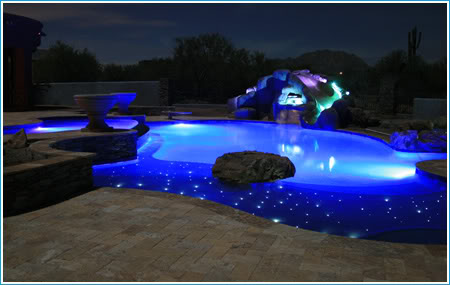In many houses, swimming pool is considered as a sign of wealth and it can be a great relief during hot summer days. Many people enjoy swimming at night during the summer and their experience could become enhanced with the use of proper lighting. We could add secondary lighting as a decorative component. They should provide enchanting sparkles to the mosaic wall of the pool and the water. However, organizing proper decorative lighting for our pool could become rather tricky. We should know how the light affects the surrounding area, if we are planning to set up lamps inside and outside the pool. In general, our swimming pool area would look great after we add proper lighting.
Well-illuminated pool area should cheer up people who swim in the pool. Specific lamp models could make the area cosier and there’s no doubt that it will become a great place for people to relax after a long day at work. We should make sure that lamps can effectively accentuate specific designs of the landscape. We may want the area to be happy and bright, but with proper arrangement, we could make the area to look romantic and quieter, only by flicking a few switches.

Here are things we should consider before implementing lighting for our pool:
1. Types of Lamps
Decorative lights could be underwater lighting system or upper lighting system. Water is a great medium for experimentation due to its wonderful reflective characteristics. Light that reaches the upper surface will be reflected and only a small portion of light goes deeper under the surface. On the other hand, light that is projected from underneath the water surface could brings more magical colors as it is spread more evenly under the surface. With proper positioning, intensity and color, the result could become rather astounding. Therefore, the upper lighting system is more for its functional role to light up the surrounding area, although they could work well as decorative elements too. For lighting above the water, it is better to use halogen bulbs with higher output intensity. On the other hand, colored LED lighting system is often used for the underwater uses. LED bulbs require much less electricity and can be installed more easily under the water.
2. Water and Electricity
Unfortunately, water and electricity can become a dangerous combination. In this case, we should try to avoid potential problems to ensure safer usages. Safer lighting requires better insulation from moisture, especially if it is placed under the water. The upper lighting system should also withstand rainwater and dust. There are technical characteristics that we need to consider and we must use components that are used for specific aims. In this case, it is a bad idea to insist on using non-water shield components for underwater installation. Other than LED, fiber optics lighting could also become a highly safe system for underwater usages. They can create a wonderful light show, although this method can be somewhat more expensive. Fiber optics is also specifically durable and they have an amazingly long working life.























